The rose is probably one of the most beautiful and popular flowers in the world. Here you can find out everything you should know about the flower queen in the garden.
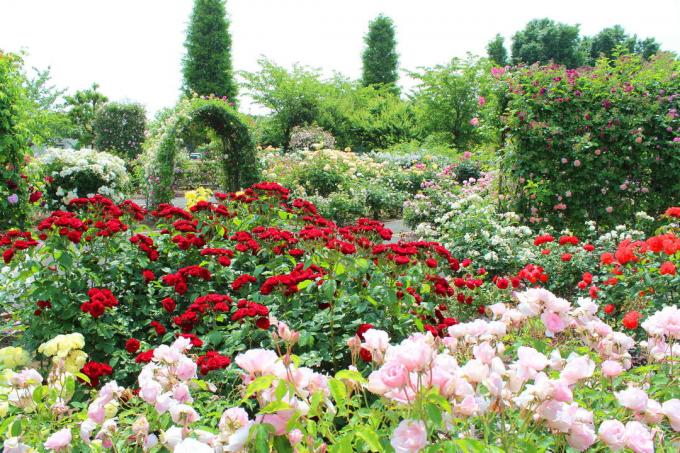
Together with other genera, roses form (pink) the large rose family (Rosaceae). Their close relatives include fruit trees such as Apple (Malus) and pear (Pyrus), but also Strawberries (Fragaria), Raspberries (Rubus idaeus) and Blackberries (Rubus fruticosus). Typically roses have five petals. Due to breeding and crossbreeding with other species, there are now numerous varieties with double or unfilled flowers in many different colors and shapes. From a botanical point of view, rose plants do not have thorns, as the Brothers Grimm claim in one of their famous fairy tales, but rather thorns. Nowadays, however, there are already some stingless varieties that make the care of roses a lot easier.
If you don't have a rose of your own, you should consider getting one now at the latest. With the big one
Selection of rose varietiesthat the specialist trade offers, you will surely find what you are looking for. We explain below what you need to consider when planting, caring for and propagating roses.contents
- Roses: meaning and origin
- Types and varieties of roses
- Buy roses
-
Plant roses
- The right location for planting roses
- When to plant roses
- Plant roses in pots and tubs
- Put on rose arch
- Propagate roses
-
Caring for roses
- Watering roses
- Fertilize roses
- Cut roses
- Hibernate roses
- Common diseases and pests in roses
- Preserving roses and making them durable
Roses: meaning and origin
Fossils have been found that show that roses existed more than 25 million years ago. The rose was given the title "Queen of Flowers" by the Greek poet Sappho around the year 600 BC. Chr. Roses originally came from Persia, where they were used as medicinal products. Later, in ancient Rome, they were also used as decorations for celebrations and were imported from Egypt in unimaginable quantities.
Today roses grow in almost every garden and play a major role in every florist shop because of their beautiful flowers. Cosmetics, on the other hand, have taken a liking to rose oil and rose water, which is obtained from the plant. In fact, rose oil was once more valuable than gold. In the wholesale trade, a liter of real Bulgarian rose oil costs up to 10,000 euros - which is hardly It is surprising, after all, it takes around 5,000 kilograms to produce this amount Rose petals.
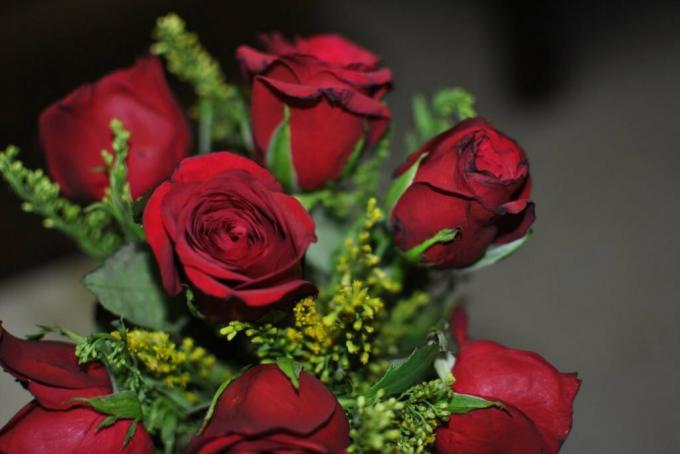
Types and varieties of roses
The rose is used in botany in different species divided. Colloquially, however, individual rose varieties are often summarized again according to their properties or their use in groups or classes. The old roses, also known as historical roses, only include those varieties that were already cultivated before 1867. Among the first modern roses are those Hybrid Tea Roses (or hybrid tea), which were crossed from Chinese tea roses and European remontant roses. According to the growth form, a distinction is made between Floribunda roses, Shrub roses, Ground cover roses and Climbing roses. Thanks to modern plant breeding, there are now also small dwarf roses and aromatic scented roses as well as tree roses that have been refined and look like a small rose tree.
In the following we would like to introduce you to a few selected types of roses:
-
Hybrid tea ‘Gloria Dei’
Best-selling hybrid tea in the world; has yellow, densely filled flowers with a light fragrance; more often blooming; easy to care for and robust variety with good winter hardiness; reaches a height of 70 to 100 cm
-
Hybrid tea ‘Ascot’
Has bright purple purple flowers; strongly fragrant; more often blooming; compact growth; suitable for cultivation in pots; high leaf health; inspires with long-lasting blooms
-
Shrub rose Fireworks ’
Has semi-double, fire-orange flowers with a delicate fragrance; more often blooming; grows upright and reaches heights of up to 150 cm; suitable for hedge planting

-
Shrub rose ‘Snow White’
Has semi-double, white flowers with a delicate fragrance; lush flowers from June to September; broad, upright growth with overhanging shoots; reaches heights of growth of up to 120 cm; extremely hardy
-
Climbing rose ‘New Dawn’
Delights us with loosely double flowers in creamy pink; flowers from June to October; pleasant scent of Gravenstein apple; strong-growing with long, overhanging shoots; Trellis necessary; reaches heights of up to 300 cm; pretty tough
-
Climbing rose ‘Golden Showers’
Has semi-double, yellow flowers; more often blooming; upright bushy growth; reaches heights of growth of up to 250 cm; suitable for rose arches; also tolerates partially shaded locations; good leaf health
-
Potato rose (Rosa rugosa)
Belongs to the wild roses; makes simple, dark pink flowers; undemanding and easy to cut; Shoots are covered with many spines; very robust and hardy; suitable for hedge planting
A comprehensive collection of different Rose varieties for every purpose can be found here.
Buy roses
Only strong, healthy roses will grow well and delight you with a rich display of flowers. Unfortunately, however, some rose varieties are very susceptible to fungal diseases and pest infestation. Therefore, when buying, you should pay attention to possible signs of illness. If you want to be on the safe side right from the start, you should choose particularly robust ones sorts the end. You will usually be given very good advice on this in rose or tree nurseries. What is the Buying roses other things to note, we have summarized for you in our special article.
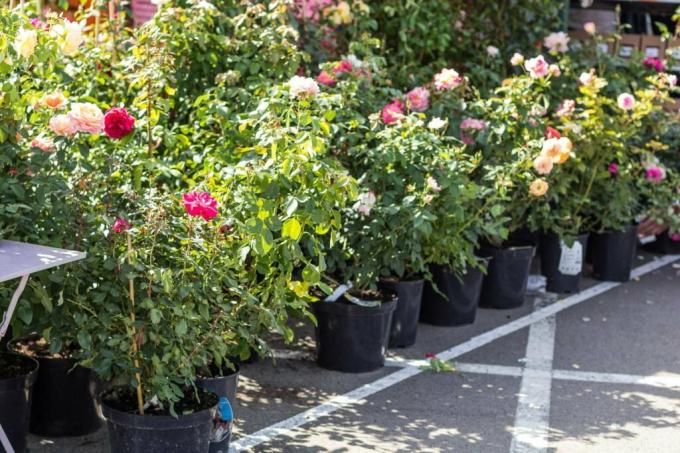
Plant roses
Roses have special requirements for their location. In the following, we explain exactly what these look like and what else you need to consider when planting roses.
The right location for planting roses
A sunny, airy place in a sheltered location is ideal for your roses. The soil in which they grow best is deep, loose, and rich in nutrients. To avoid heat build-up in summer, however, you should not keep roses too close to one Place the house wall and ensure that there is enough distance from other plants to ensure that there is competition for nutrients avoid. If the soil becomes “rose-tired” after a few years, you should consider the location before cultivating roses again with other ornamental plants - such as Tagetes (Tagetes patula) - plant and wait a few years before replanting.
When to plant roses
You can buy roses in containers all year round. However, the best time to plant new roses is in autumn (October / November) so that they have enough time to take root over the winter. In areas with a harsher climate, however, roses can still be planted in spring, but then they have to be watered particularly well when budding begins.
A comprehensive article on "Plant roses" You will find here.
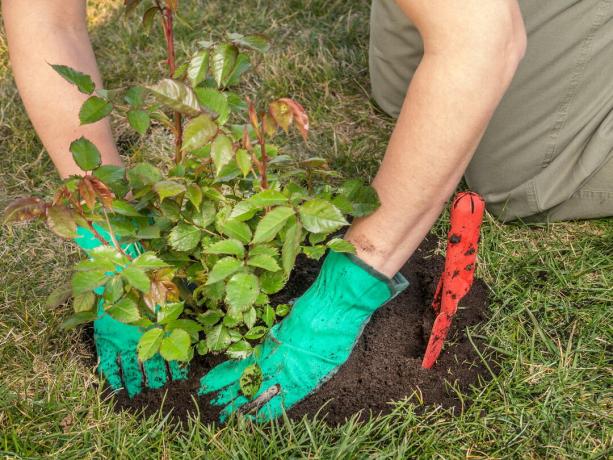
Plant roses in pots and tubs
Smaller rose varieties can be wonderfully planted in a pot or tub, provided that there is enough space for the deep-rooting plant. Since potted roses do not tolerate waterlogging, it is best to first put a drainage layer made of gravel or expanded clay in the planter so that excess water can drain off. Then fill it up with specialty soil from the trade or a mixture of garden, compost and potting soil. Once the rose has been planted, place the pot or bucket in a sunny, airy spot on the balcony or terrace. But don't forget to water the rose regularly from now on so that it doesn't dry out. A detailed guide to the Planting potted roses as well as further care instructions can be found here.
Put on rose arch
A climbing aid in arch form only becomes a real eye-catcher when it is overgrown by climbing roses. Even before creating a rose arch, some aspects should be considered - such as the selection of a weather-resistant material and firm anchoring in the ground. The location should not only please the gardener, but also the rose, which should grow vigorously and produce many flowers. How to make your own Put on rose arch we explain again in detail in our special article.

Propagate roses
If you haven't had enough of the flower queen, you can propagate your garden and cut roses yourself in various ways. Growing small rose plants from the seeds of the rose hips is probably the most expensive. Fortunately, some types of roses can also be reproduced very well using cuttings and cuttings. With their long shoots, climbing and rambler roses can even be propagated using lowering devices. Grafted plants are often commercially available, but this method requires expertise and a lot of practice in order to be able to carry out it successfully. Information on which Propagation method for which roses and detailed instructions on how to do this can be found here.
Caring for roses
Only a rose that is completely comfortable will delight you with many flowers. Therefore, we have summarized the most important points for rose care - from watering and fertilizing to correct winter storage - for you. A detailed article on the subject of "Caring for roses“Can also be found here.
Watering roses
Roses should be watered regularly, especially in the early days. On hot summer days, however, it is also important to ensure that older plants are adequately watered. You can tell the right time to water roses by taking a finger test, because the soil should always be moist, but not wet. Especially when cultivating in pots, you should make sure that the roses do not sink into waterlogging. Here you will find a special article on the subject of "Watering roses“.
Fertilize roses
Roses are very consuming plants and should therefore be fertilized regularly. It is best to use a fertilizer with an organic long-term effect such as ours Plantura organic rose fertilizer. This is slowly broken down by the microorganisms in the soil and provides your rose with sufficient nutrients over a longer period of time. The first fertilization can be done in spring (March / April) to support the rose with new growth. A second fertilization is then recommended at the beginning of the flowering phase at the end of May. Rose varieties that bloom more often receive a final fertilization during the main bloom at the beginning of July in order to provide the plant with sufficient nutrients for the second secondary bloom. As you did with the Fertilizing roses proceed correctly, we explain again in detail in our special article.

Cut roses
In addition to the adequate supply of water and nutrients, the right pruning is also important for optimal development of the rose. An annual basic pruning is best done in spring (March / April) before the new shoots. Sick and broken shoots can also be removed during the growing season. Depending on the type of rose, the pruning procedure varies somewhat. Precise instructions for the Rose cut You will find here.
Hibernate roses
In order for your roses to survive the winter well, you should take a few protective measures. First remove the old inflorescences and leaves as well as the fallen leaves on the ground to prevent infestation with diseases. Then pile up the earth around the rose about 20 centimeters high and stick fir green between the shoots. Specialized garden fleece for the crown and bamboo mats for the trunk are also available from specialist retailers to isolate tall-stem roses. In our special article you will find detailed step-by-step instructions to help you with the Wintering your roses certainly nothing goes wrong.

Common diseases and pests in roses
If you notice a white coating on the leaves and buds of your roses, it is most likely powdery mildew infestation (Erysiphales). Unfortunately, other fungal diseases also occur - such as star soot (Diplocarpon rosae) or rose rust (Phragmidium) - very often on roses. Damage to sucking and feeding are in most cases caused by rose aphids (Macrosiphum rosae), Rose leaf hoppers (Edwardsiana rosae) or the larvae of the rose wasp (Caliora aethiops).
More detailed information on Rose rust, Powdery mildew on roses and Soot as well as suitable measures to combat it can be found in the respective special articles.
An overview of the most important Rose diseases and pests We have prepared for you with clear damage images to identify the unpleasant residents.
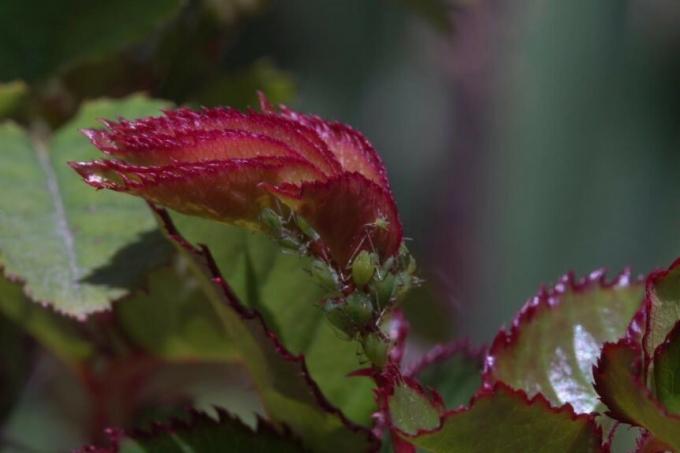
Preserving roses and making them durable
At the end of the year, you might want to keep your darlings blooming for a longer period of time. Perhaps you have already candied the petals of your roses in sugar syrup and then nibbled them? The simplest and best-known method of making roses durable is probably to dry cut roses in an airy place. Unfortunately, this makes the flower very brittle and often changes its color. However, this is not the case with gentle drying with silica granulate, which slowly removes moisture from the plant. Whole bouquets of flowers, on the other hand, are easiest to preserve with glycerin, which is available at the pharmacy. As Making roses last we explain again in detail in our special article.



